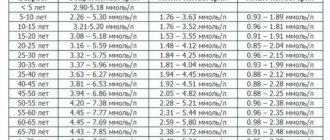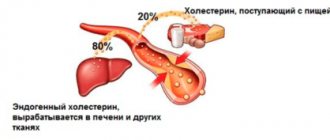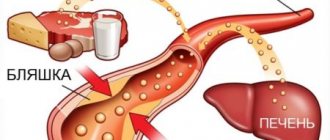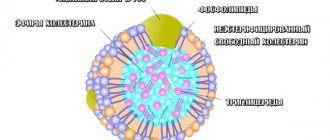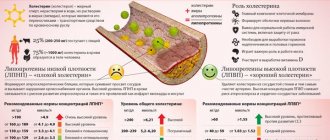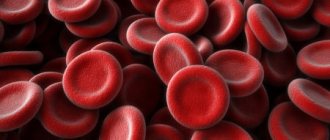Ekaterina Smolnikova
Practicing endocrinologist (10 years of experience). He has extensive experience working in private and public clinics in Russia.
Ask a Question
Last updated on August 16, 2020 at 01:17 pm
An important indicator of the risk of atherosclerosis is the level of cholesterol in the blood. The norm in men varies according to age and is measured using a blood test. Both an increase and a decrease in indicators are considered equally dangerous. The ratio of “good” and “bad” cholesterol is also of great importance.
Possible reasons for the increase
Increased cholesterol is based on a physiological mechanism. The main element is cholesterol. It is a fatty alcohol that is used for:
- Productive metabolism of steroid hormones;
- The natural synthesis of cholecalciferol (under the influence of sunlight) and ergocalciferol (supplied with food) are vitamins of group D;
- Construction of cell membranes.
Normally (cholesterol 7.0 mmol/l) is produced by the cells of the largest human gland - the liver. Stereol synthesis is supported by the work of the adrenal glands, intestinal tract, and skin. These are additional functions of lipid metabolism that are associated with the formation of cholesterol plaques.
A newborn's cholesterol level is low, equal to 1-2 mmol/l. Unlike men, cholesterol levels are maintained as long as the production of the typical female hormone is normal. Only after menopause in the fair sex does the risk increase. In men it is present, but in lower concentrations, so they are more often at risk of detecting “cholesterol 7 mmol/l.” in their blood.
Life forecast
You should not completely give up foods containing cholesterol, because many of them are suppliers of animal protein to the body.
If you give up bad and destructive habits - alcohol and nicotine, and also constantly adequately load your body, then moderately consumed cholesterol-containing foods will not lead to a rapid jump in the cholesterol index.
Timely blood biochemistry for cholesterol will allow you to correct the indicators to normal, which will prevent the development of heart pathologies and atherosclerosis. With the right lifestyle, the prognosis is favorable.
Who is at risk?
Due to physiological characteristics, males are most at risk. Due to disruption of hormonal systems in women, the risk zone expands significantly, especially in adulthood. All problems can begin earlier if you do not pay attention to indicators.
Medical experts believe the following categories are at risk.
- Passive, inactive with signs of physical inactivity. Blood must constantly circulate, and this can only be ensured by physical activity.
- Alcohol abusers, when the functioning of the gastrointestinal tract and liver is disrupted.
- People who allow themselves to break their diet or not follow the basics of proper nutrition are at risk when the cholesterol value is 7 mmol/l. and above is discovered by chance.
- Obese, sedentary people.
- Women with hormonal system failure.
- Elderly and senile age, regardless of gender, when estrogen production decreases or stops. It is he who is responsible for the regulation of cholesterol.
A special risk zone is childhood, especially adolescence, when hormonal levels increase. Diagnostics allows us to identify the onset of the disease.
Diagnostics
The method of biochemical analysis of blood composition using the lipogram method provides the most accurate results of lipoproteins by fraction, as well as the concentration of triglycerides.
To properly donate blood for lipid spectrum testing, you need to prepare your body the day before blood collection:
- Donate blood from a vein on an empty stomach - do not eat for at least 8 hours before donating blood, but for a maximum of 12 hours. It is forbidden to fast any longer, because the body may become exhausted;
- Do not eat fatty foods the day before, as well as foods only based on carbohydrates;
- One day or two before taking blood for biochemistry, do not drink alcohol;
- 3-4 hours before the biochemical procedure - stop smoking;
- A day or two before blood sampling, do not physically overload the body;
- Donate blood in a calm state.
If all the rules for preparing the body are followed, and the cholesterol index is not lower than 7.0 mmol/l and even higher than this, it means that the body has started the process of developing atherosclerotic changes in the bloodstream and in the cardiac organ.
Donate blood from a vein on an empty stomach
Signs of deviation from the norm
Excessive formation of cholesterol plaques at the initial stage occurs unnoticed. There are no obvious symptoms, complaints, or poor health.
The first signs of a malfunction in the body are expressed in later, delayed periods, when not only prevention is necessary.
High cholesterol is accompanied by:
- From the musculoskeletal system: a feeling of stiffness, heaviness, tremor in the limbs; varicose veins of the knees, legs, feet; redness and blueness;
- Cardiac pathology: shortness of breath, tachycardia or bradycardia, chest pain;
- In reproductive function: early menopause, decreased fertility, potency, loss of interest in sex (frigidity);
- Decreased visual acuity, identification of a gray rim around the cornea;
- Violation of brain functions: memory, thinking, attention, concentration.
A specific symptom is the formation of xanthomas. These are fatty plaques on the surface of the skin, filled with a white mass, concentrated around the eyes, on the palms, soles, fingers, and buttocks.
If at least one or more signs are detected, then this is a reason to seek medical help.
Causes of high and low cholesterol
In women and men over 40 years of age, excess cholesterol in the blood may be associated with genetic defects in lipid metabolism, but more often the cause remains unknown. Factors that contribute to increased blood cholesterol levels include:
- liver and gallbladder diseases;
- smoking;
- tumors of the pancreas, prostate gland;
- gout;
- chronic renal failure (the causes and treatment of kidney disease in women are described here);
- endocrine pathology (insufficient production of somatotropic hormone, diabetes mellitus, hypothyroidism).
In women, the cause of increased blood cholesterol compared to the norm can be pregnancy. Those who are planning to get pregnant after 40 need to know this.
Reduced lipid values are observed with:
- starvation, exhaustion;
- extensive burns;
- severe infections (treated by an infectious disease specialist);
- sepsis;
- malignant liver tumors (diagnosed and treated by an oncologist);
- some types of anemia;
- chronic lung diseases (read how to treat chronic bronchitis in this article);
- rheumatoid arthritis;
- hyperthyroidism.
Low blood lipid levels also occur in those who are vegetarians or take medications such as neomycin, thyroxine, ketoconazole, interferon, and estrogens.
Methods for determining blood cholesterol levels
In a biochemical analysis of a person, one of the vital indicators that determine the general condition of the body is cholesterol in the blood. Modern laboratories are equipped with special equipment that eliminates errors in data calculations.
Therefore, 30 years ago it was not possible to accurately determine the amount of cholesterol. On this basis, most patients consider the fact far-fetched and not dangerous. As a result, they do not listen to recommendations on dieting, exercise and treatment.
To determine cholesterol, no more than 5 ml of venous blood is taken with a special vacuum syringe. The tube is marked with the name, age of the patient, date and time of collection.
Another method is a portable biochemical device for determining cholesterol in the blood. It is a small box that looks like a glucometer. Using a test strip and lancet, the patient can determine the levels of: uric acid; cholesterol; triglycerides; glucose. The device can do analysis at home. Most often used for express diagnosis of acute conditions during pre-medical appointments.
Only a comprehensive examination of the body will make it possible to make an accurate diagnosis and prescribe the correct treatment under medical supervision.
The accuracy of the indicators will increase strict adherence to the rules of blood sampling:
- The test is taken on an empty stomach (more than 8-10 hours have passed before the last meal) in the morning;
- You cannot drink alcohol 1 day before going to the laboratory, it disrupts lipid metabolism;
- In case of thirst, plain water without additives or gas is allowed;
- Smoking is not allowed an hour before the test;
- Physical activity and psycho-emotional disorders are completely excluded.
Find out from your doctor exactly which pills you should not take so that the analysis is as “clean” as possible.
Low cholesterol
Cholesterol levels may fall - this is hypocholesterolemia, it is spoken of when TC levels fluctuate in the digital range from 5 to 3. It is believed that this is a marker of liver disease, a valuable diagnostic sign. Sometimes a laboratory blood test for cholesterol is the only precursor to the development of inflammation or tumor of an organ or its biliary system.
Hypocholesterolemia has not yet been sufficiently studied, but it is already clear that the causes of the pathology can be:
- incorrect use of anti-atherosclerotic drugs;
- liver diseases;
- prolonged fasting;
- intestinal pathology;
- stress;
- hyperthyroidism;
- anemia;
- intoxication of various origins;
- fever of infectious etiology;
- sepsis;
- hereditary predisposition.
Cholesterol deficiency often becomes a “headache” for professional athletes who cannot choose the appropriate diet. The lack of energy associated with this condition does not allow achieving high results.
There are no clinical manifestations that would help to accurately make a diagnosis. A biochemical blood test is needed. However, hypocholesterolemia can be suspected based on the following signs:
- muscle weakness;
- lymphadenitis;
- lack of appetite;
- admixture of undigested fat in feces;
- decreased reflexes;
- aggressiveness or depression;
- a sharp decrease in erectile dysfunction.
Pathology is treated by endocrinologists, sex therapists, and neurologists after preliminary tests.
What does a reading above 7 mmol/l mean?
A high level of indicators is an alarming sign of the development of serious pathologies. Physiology “works” so that excess sterol settles on the walls of blood vessels, and plaque formation begins. The process looks like this:
- In the initial stage, they look like stripes, fatty spots that do not interfere with blood circulation.
- As they grow, they narrow the openings in the arteries.
- Vessels are clogged.
As a result, the organs do not receive enough nutrients and oxygen. Cholesterol plaques can break off, accumulate and completely block blood access to the heart.
A similar situation occurs with the brain and limbs. A cerebrovascular accident causes a cholesterol level of 7.9 mmol/l. and higher,” a stroke occurs with complications including paralysis of vital functions and death.
Atherosclerosis disrupts trophism in the lower extremities, swelling, dry skin. Any injury becomes a threat of severe pathologies (gangrene, venous stagnation). The only way out is amputation.
Why is cholesterol needed?
This is a fat-like alcohol, without which the normal functioning of the entire body and each of its cells cannot take place.
Cholesterol has the properties of increasing the functionality of the immune system and increasing the body's defenses against the invasion of infectious and viral agents.
The effect of cholesterol on the body:
- Cholesterol is found as a building component in cell membranes, making them more elastic, stronger and increasing their permeability;
- Participates in the production of steroid hormones by the adrenal glands;
- With the help of lipoproteins, vitamin D is synthesized in liver cells;
- With the help of cholesterol, the gallbladder functions and produces bile acids;
- The properties of cholesterol are to bind between neuronal cells in the spinal cord and in the brain;
- Lipoproteins are found in the sheaths of nerve fibers.
Cholesterol is a very important component in the body, but its too high concentration in the blood can lead to serious disruptions in the functioning of the blood flow system, as well as the heart organ, which in a complicated form quite often leads to death.
Cholesterol is a very important component in the body
How does he appear?
There are 2 ways cholesterol molecules enter the human body:
- 80.0% of the total amount of cholesterol is produced by the body itself using liver cells . Cholesterol is synthesized using the reductase enzyme, which is produced by the body in the intestines, in liver cells, and with the help of human skin;
- 20.0% of cholesterol enters the body with food of animal origin, which contains cholesterol molecules . In addition to cholesterol molecules as fat, protein molecules, minerals and carbohydrate molecules enter the body. The totality of all these substances produces energy for the functioning of the human body.
If, according to the results of laboratory diagnostics, a cholesterol index of 7.0 mmol/l and up to 8.0 mmol per liter is recorded in a person, this means that lipid metabolism is disturbed in the human body and it is necessary to look for the cause in problems within the body and reduce the intensity of synthesis in liver cells cholesterol molecules.
Cholesterol levels - 7.0, 7.2, 7.5 and more - can only raise internal problems in the synthesis of lipid molecules.
With the help of improper nutrition, it is almost impossible to raise the cholesterol level of 7.0 mmol/l.
Cholesterol rises to 7.0 mmol/l only with a combination of many factors, one of which is poor nutrition.
Types of molecules
The activity of the body in the bloodstream is due to its connection with proteins, which have excellent transport capabilities in the bloodstream. In accordance with the amount of protein in the lipoprotein molecule, its transport ability is determined.
Therefore, the beneficial properties of the body depend on such compounds. Based on the amount of protein in the molecule, cholesterol is divided into good (useful) and bad (harmful).
Total cholesterol in the blood is divided into several fractions:
Very low density lipoproteins (VLDL).
These lipoproteins are synthesized in liver cells and contain cholesterol and most triglyceride molecules. If the level of VLDL in the body is increased, then this is a signal that lipid metabolism in the body is disturbed and it is urgently necessary to take measures to correct it.
Elevated lipoproteins of very low molecular density lead to serious disturbances in the blood flow system and the development of the pathology atherosclerosis, and also have a detrimental effect on the myocardium, causing serious pathologies of the cardiac organ.
Low-density lipoproteins (LDL).
This is what people call bad cholesterol. In this lipoprotein molecule, the presence of protein is small. And the main concentration in the LDL molecule is cholesterol and triglycerides.
Due to their low molecular density, low molecular weight lipoproteins, in the process of moving through the bloodstream, lose cholesterol particles, which settle on the inner sides (on the intima) of the vascular membranes in the form of a fatty spot, which begins to attract more fat molecules, forming a cholesterol plaque.
The cholesterol plaque begins to become overgrown with calcium molecules, turning into a hard atherosclerotic plaque that closes the arterial lumen.
With a cholesterol index of 7.0 mmol/l, the process of formation of atherosclerotic changes in blood vessels and the development of the pathology atherosclerosis has already begun in the human body.
In the heart organ, when the cholesterol index is 7.0 mmol/l, ischemia of the heart muscle, an unstable type of angina, begins to develop. If the cholesterol level reaches 7.8 and 8.0, then this means the risk of developing pathologies of myocardial infarction, or cerebral stroke.
The higher the cholesterol level after indicator 8, the more dangerous the transition of all cardiac pathologies of the bloodstream system and cardiac organ into a complicated form, which leads to death.
High-density lipoproteins (HDL).
This is good cholesterol, which, having a high molecular weight form, actively moves through the bloodstream, has the ability to collect free cholesterol molecules, which are particles that have broken off from low molecular weight fractions of lipoproteins, and transports them to liver cells for subsequent utilization by bile acids.
If, with an indicator of 7.0 - 7.8 mmol per liter, the HDL fraction predominates in the blood composition, then this means that a person has a minimal risk of developing pathologies of the heart organ and pathologies of the vascular system.
Based on the test transcripts, with an index of 7.2, if the HDL fraction predominates, then this is not so scary for the body, and there is no reason to urgently reduce total cholesterol.
It is simply necessary to systematically monitor the composition of the blood for lipoproteins using the lipid spectrum method in order to promptly, when the concentration of predominant fractions in the blood composition changes, begin treatment to reduce the TC index and LDL fractions, as well as very low molecular weight lipids.
Is total cholesterol level 7.0-7.9 normal or too much?
Despite general reference values of around 3 units, there are several factors that are considered normal.
- The boundaries lie within the range of “cholesterol 7.1-7.2 mmol/l” if the patient is over 50 years old.
- For older women, the norm is when cholesterol is 7.3-7.85 due to decreased reproductive functions and the effects of estrogen.
- During pregnancy, levels reach 9-13 mmol/l. against the background of hormonal changes.
If an excess of 7.9 mmol/l is detected by doctors under the age of 45, then this level is critical and requires additional research and preventive measures.
If cholesterol is higher than 7.0 -7.9, then screening tests are prescribed. The patient must undergo tests every six months.
Tables of cholesterol norms (decoding results):
- norms of total cholesterol in a blood test;
- normal LDL/LDL-C (low-density lipoprotein cholesterol);
- normal HDL/HDL-C (high-density lipoprotein cholesterol);
- norm of NON-HDL cholesterol (non-HDL-C = TC - HDL-C);
- TG/TRIG standards (triglycerides in blood serum);
- cholesterol standards in children and adolescents (by age);
- cholesterol standards in adults (by age);
- cholesterol standards in older men and women.
Treatment of high cholesterol
If a cholesterol level exceeds 7 mmol/l, the therapist prescribes several therapeutic measures that can not only reduce, but also maintain normal levels.
Nutritional correction to reduce cholesterol 7 mmol/l
The first thing you need to do is adjust your diet. A “cholesterol-free diet” is prescribed. It is based on the following principles.
- All dairy products with a high fat content are excluded: cheeses, sour cream, cream.
- You cannot eat smoked meats and lard: sausages, brisket, boiled pork, ham, sausages, grilled wings and the like.
- Fresh baked goods will be prohibited. They are replaced with crackers, dried slices of bread. No vanilla buns with jam, pies or buns.
- Forget about snacks (chips, dried fish, etc.).
- A dangerous product for cholesterol is alcohol. It disrupts the functioning of the liver and pancreas.
- Carbonated waters, especially sweet types, harm lipid metabolism.
It is better to make all food products yourself.
Physical activity as a method of combating high cholesterol
Since the formation of cholestorol and its regulation directly depend on the general blood supply and metabolism system, moderate physical activity is prescribed. This is a means of not only prevention, but also treatment.
- Easy calm jogging;
- Walking at a moderate pace;
- Morning exercises, fitness in the gym under the guidance of a trainer;
- Walking in the morning or before bed.
Do physical activity while working. Take a walk, walk, stretch.
Non-drug treatment
Among the recommendations when it is necessary to reduce cholesterol, there are often non-drug treatment methods. It is suitable for the initial stage of the disease and is only being developed. Effectiveness assessment is carried out 1-3 months after the start.
- Laser therapy, when plaques are removed using a targeted method. Complications are possible due to the formation of microparticles and thromboembolism.
- Ultrasound cavitation method. Under the influence of high frequencies, cholesterol plaques are removed, stagnation is destroyed, passages in the vascular beds become freer. Tested on the lower extremities when the patient faces amputation.
The effect of such procedures brings results, but so far this has not been implemented everywhere, since lipid metabolism, its features, and the formation of cholesterol are all associated with other pathologies.
Drug treatment
The general practitioner prescribes statin drugs, which prevent the formation of cholesterol plaques and are mood stabilizers for lipid metabolism. Active ingredients: lavostatin, fluvastafin, simvastatin, pravastatin. The most effective for severe pathologies are:
- Choletar, Cardiostanitis (the main substance is lovastatin), reducing the levels to 6-4 mmol/l;
- Mertinil, Roxera, Crestor with rosuvastin;
- Lexol Forte based on fluvastatin, effectively affecting high values (from 9 mmol/l. and above);
- Owencor, Simvastol, Vasilip with fluvastine, allowing to achieve stable results with long-term use for more than 4 months.
Taking into account that increased cholesterol is associated with pathological processes of other diseases, therapy should be comprehensive, depending on the pathology.
They use cardiac glycosides that reduce heart rate, as well as: hormones (if endocrinological disorders are detected); hepatoprotectors.
Normal cholesterol levels in men (table)
The content of cholesterol in the blood of men changes at different age periods. It is important for a man to control cholesterol levels, since the male body is more susceptible to atherosclerosis. In women, female sex hormones - estrogens - are responsible for maintaining normal levels. Men have no such protection.
The amount of lipoproteins changes every five years. The amount of total cholesterol in a child matters. After five years, he is divided into good and bad. What is important is not so much the quantitative values as the atherogenicity index. AI is the ratio of HDL to LDL. It is calculated as follows: the amount of HDL is subtracted from the amount of total cholesterol, and the result is divided by the amount of HDL. How much should the atherogenic coefficient be? The acceptable AI value for men is 3.5. An excess indicates the presence of atherosclerosis.
High AI is usually found in men who:
- They abuse tobacco.
- They don't play sports.
- They eat fast food and semi-finished products.
- They are overweight.
- They suffer from diabetes.
- Have high blood pressure.
Too low AI occurs in the following cases:
- Long-term use of cholesterol-lowering drugs (statins).
- Professional sports.
- A vegetarian diet in which a person does not receive animal protein.
The amount of total cholesterol and LDL begins to increase after 30 years. After 40 years, bad cholesterol increases even more, and the risk of atherosclerosis increases. It is especially important to control lipoprotein levels in men over 50 years of age. But after 60 years, the content of bad cholesterol decreases, reaching a minimum value by 70 years.
The norms for cholesterol levels in men by age are shown in the table.
| Person's age | Content of total cholesterol, mmol/l | Content of bad cholesterol | Contents of good cholesterol |
| Up to five years | 2,9-5,19 | ||
| From 5 to 20 years | 2,9-5, 09 | 1,6-33,36 | 0,77-1,62 |
| 20-30 | 3,43-6,31 | 1,8-4,26 | 0,79-1,62 |
| 30-40 | 3,62-6,98 | 1,93-4,43 | 0,87-2,11 |
| 40-50 | 4,08-7,16 | 2,5-5,22 | 0,77-2,65 |
| 50-60 | 4,03-7,14 | 2,27-5,25 | 0,71-1,83 |
| 60-70 | 4,08-7,08 | 2,48-5,32 | 0,77-1,92 |
| After 70 | 3,7-6,85 | 2,48-5,32 | 0,84-1,91 |
Article on the topic:
The norm of creatinine in the blood of men depending on age
Thus, the average TC value fluctuates around 5 mmol/l. If both HDL and LDL are elevated, this means that good cholesterol suppresses bad cholesterol and protects blood vessels. High LDL and low HDL are dangerous.
Why is high cholesterol dangerous?
Elevated cholesterol levels are a high risk of sudden death and disability due to strokes, myocardial infarction, obesity, and decreased reproductive functions. If its indicators exceed the norm of 7.9 mmol/l, then you will need:
- Review of daily routine and nutrition;
- Elimination of potentially dangerous risk factors, normalization of the cardiovascular system, digestion;
- Constant monitoring of the level of indicators of disturbances in lipid metabolism and cholesterol.
The older you get, the higher your risk of developing cholesterol plaques.
Watch your diet, don’t break your routine and diet, live an active life! We will defeat cholesterol only if we strictly follow the recommendations.
Table: HDL-C cholesterol levels
| Decoding the results: | HDL cholesterol (mmol/l) | HDL-C (mg/dL) |
| low level (increased risks) | less than 1.0 (for men) less than 1.3 (for women) | below 40 (for men) below 50 (for women) |
| borderline values (medium risks) | 1.0 - 1.3 (for men) 1.3 - 1.5 (for women) | 40 – 50 (for men) 50 – 59 (for women) |
| excellent result (“negative” risk factor; “longevity syndrome”) | over 1.55 | more than 60 |
| too high (possibly hyper-alpha lipoproteinemia) | over 2.1 | more than 80 |
| dangerous values (according to the latest studies) | over 3.0 (for men) over 3.5 (for women) | more than 115 (for men) more than 135 (for women) |
HDL (HDL-C)
very “good” alpha cholesterol.
Has unique antiatherogenic properties. That is why its increased concentration is called “longevity syndrome”
.
This class of lipoproteins, figuratively speaking, “washes away” their bad counterparts from the walls of the arteries (sending them back to the liver for processing into bile acids), which significantly reduces the risks of developing a wide range of cardiovascular diseases and atherosclerosis
(“the silent killer”).
We recommend that you read: what is the atherogenic coefficient and why is it calculated?
Physical activity as a method of combating high cholesterol
By contacting a specialist, you will receive clear recommendations on how to further combat the disease. He will tell you the dangers of cholesterol 7, what it means, and why you should reduce its level.
One way to combat this problem is to increase physical activity. Exercise requires energy. If it does not come from outside, then the body uses up internal reserves. Energy is provided by accumulated fats. Their breakdown and removal also requires strength. Gradually, your cholesterol levels will normalize, exercise will become a habit, and your health will significantly improve.
You don’t have to sign up for a gym or fitness class right away. Active training will not benefit a beginner. You should think about your heart. The best option is long walks in the fresh air. Buy a pedometer to monitor the number of steps you take per day, the speed at which you move, and the distance traveled.
You can sign up for exercise therapy, yoga for beginners, Pilates. Such activities perfectly prepare for more serious physical activity.
If you are interested in whether cholesterol 7 is too much or too little, study the information on this issue. Be sure to consult a doctor. If there are no other aggravating circumstances, this level of natural fatty alcohol in the blood is elevated, but not critical, so it can be corrected with diet and exercise without resorting to drug therapy.
If the indicators do not change over a long period of time or increase, then you will have to resort to taking various medications that the doctor will prescribe.
